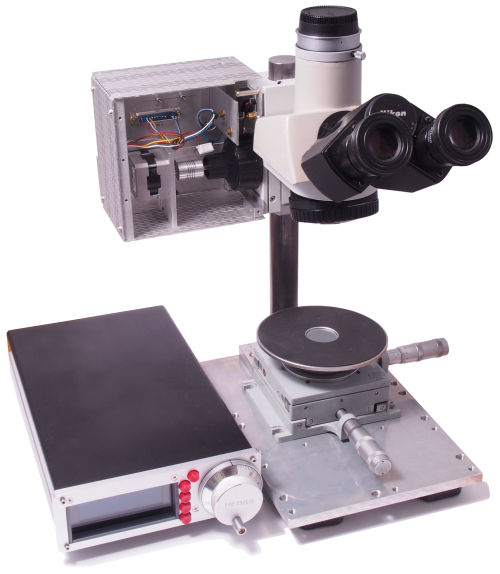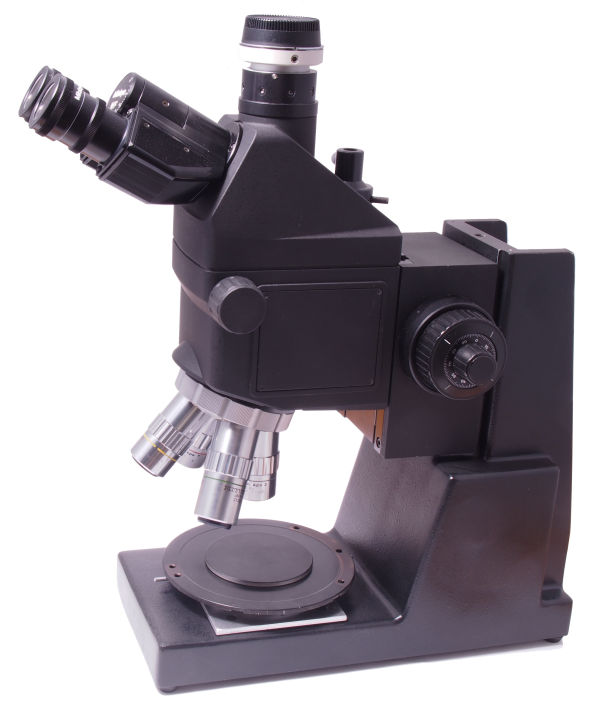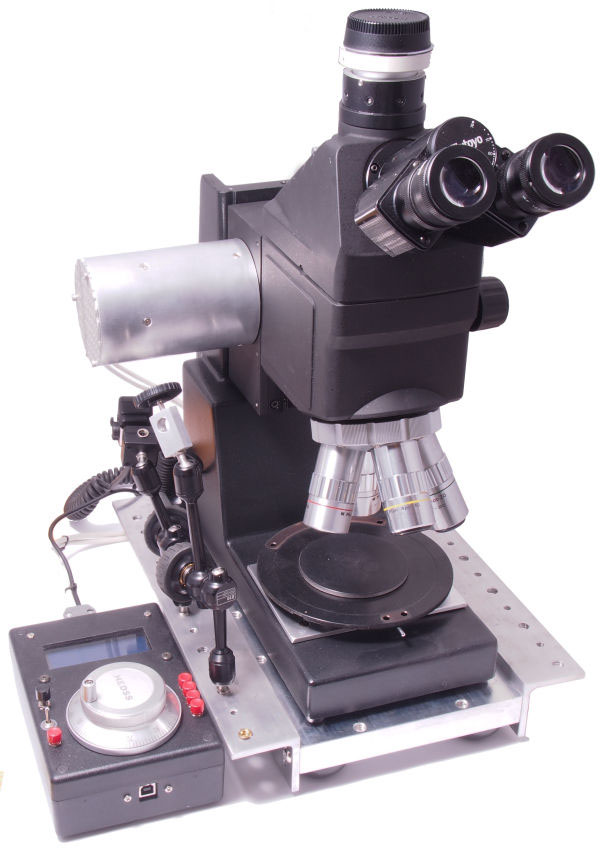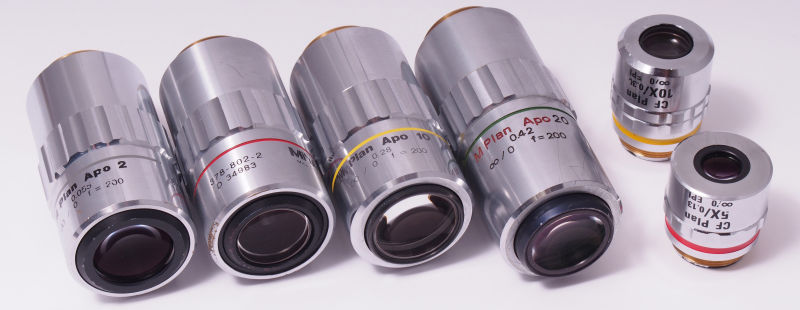Mitutoyo FS-60Preface: The final solution (for focus stacking)Focus stacking is a combination of photographic and post-processing techniques that bypasses the intrinsic limitations of depth of field, diffraction and resolution in photography. In general terms, focus stacking works by (1) taking a series ("stack") of photographs of an immobile subject at slightly different focus settings, and (2) combining together the in-focus portions of the stack images, thus obtaining a final image that displays a higher depth of field that possible in a single image. Each image in a stack can be shot with an aperture settings that does not visibly decrease resolution by introducing diffraction. The lens aperture is selected as the highest f/value that does not visibly lower resolution. This minimizes the number of slices. At the same time, a moderate amount of overlap of the DOF between adjacent slices helps the stacking software to do its job. In this way, if everything works as intended, the final image can display a high resolution (with good lenses, close to the maximum possible for a given camera) and at the same time an essentially unlimited DOF. 
A couple of years ago, I built the automated stacking system shown in Figure 1. This system, and the programming of its microcontroller, are discussed in detail in the following references: Savazzi, E. 2011: Digital photography for science: Close-up photography, macrophotography and photomacrography. 704 pp. Lulu Enterprises, Raleigh. ISBN 978-0-557-92537-7 (paperback) and ISBN 978-0-557-91133-2 (hardcover). Savazzi, E. 2011: Construction and programming of an autonomous focus stacker. Computers & Geosciences 37: 1670-1676. The above system uses photomacrographic lenses in RMS threads, as well as finite microscope objectives, and works very well for my purposes. Focusing through the eyepieces is much easier and more precise that carrying out the same operation through a DSLR viewfinder, and in my opinion is even superior to the live view now available in most digital cameras (with the possible exception of the extreme zooming sometimes possible in live view). Shortly after I finished building this system, it became clear (especially through discussions on the www.photomacrography.net bulletin boards) that infinity microscope objectives designed for incident illumination and long working distances produce better results than finite optical systems. Infinity objectives require additional optics (called "tube lens", but often consisting of multiple elements) between objective and focal plane. A number of original and "alternative" tube lenses have been tested by photographers, with varying degrees of success and practicality. Modern infinity-corrected Mitutoyo and Nikon objectives are currently regarded as particularly suitable for this use. They are also relatively frequent on the second-hand market, and their prices, although high, are not outside the reach of determined amateur photographers. Other brands of infinity objectives require original tube lenses to correct for some aberrations, while modern Mitutoyo and Nikon ones (and perhaps at least some Olympus objectives) correct all aberrations within the objective and are more tolerant of tube lenses from other manufacturers, and even of telephoto and repro lenses used in place of a tube lens. In my particular case, I was able to secure a second-hand Mitutoyo FS-60 microscope on the 'Bay (I mean eBay, not the other 'Bay, which is no good for getting hardware). This eliminates all problems connected with matching, assembling and tentatively aligning parts from different brands and models, which I was forced to do for version 1. Thus, enter: The final solution, version 2
The Mitutoyo FS-60 is a rather large industrial microscope designed to use incident inclined illumination (from an external light source) and incident coaxial illumination (via a proprietary port for an optical light guide). The current version (FS-70) differs in a few details, including a rear-facing revolving objective carrier (which is front-facing in the FS-60) and, in some variants, externally accessible slots for inserting polarizers or DIC optics in the path of the coaxial illuminator and objective. The basic design, however, remains the same. A few different options are available at order time for the FS-60 and FS-70 with regards to the internal tube lens and binocular head. Normally, these options cannot be retrofitted with separately purchased parts, so the only practical solution with these Mitutoyo microscopes is finding a suitable second-hand one (The closest thing I noticed on the 'Bay since buying my FS-60 over one year ago was a special non-zoom FS-60 factory-assembled without a binocular head, so FS-60s are quite uncommon there) or putting one together from multiple incomplete scopes (which is even less likely, given that they are not built as modular units). Tube lenses for the visible range, IR and UV can be purchased as components for building OEM equipment. New tube lenses from Mitutoyo (and the largely compatible ones from Nikon) are expensive, but not prohibitively so, and together with second-hand Mitutoyo objectives and occasional ultra-wide-angle eyepieces are about the only parts available separately from Mitutoyo scopes. Unless you have a large academic grant with no other possible use, or a customer ready to buy five years' worth of your future focus stacks, forget about buying a new FS-70 and accessories. Nikon infinity objectives for epimicroscopes (albeit not the ones equipped with an outer illumination sleeve) work mostly fine on a FS-60/70 from an optical point of view, but require thread adapters, have a much shorter working distance and produce smaller image circles. So-called Mitutoyo-compatible objectives from a few other brands are cheaper and also produce smaller image circles (which may or may not be a concern, depending on the size of the camera sensor). The tube lens of my model is for visible light and has a 2x zoom factor, continuously variable through a knob on the right side of the body casing. The knob does not carry a scale, but one can be added. The focal length of the tube lens is therefore 200-400 mm (200 mm gives the nominal objective magnification with most Mitutoyo M-Plan Apo objectives, except the QV series which is specified for use with a 100mm tube lens). 
Figure 3 shows the FS-60 in stacking configuration, mounted on a vibration-damped aluminium platform equipped with arms to support illuminators. The gliding specimen stage is adapted from an old Zeiss microscope. Not shown are light guide illuminators. The revolving objective carrier accepts four objectives with 26 mm threads (quite larger than RMS). Three of the objective mounts are centerable. 
My FS-60 is currently equipped with Mitutoyo M-Plan Apo 2x, 5x, 10x and 20x objectives (not the SL series, which trades a lower NA in exchange for a higher working distance, and consequently provides a lower resolution). The barrels of these objectives are longer than commonly available microscope objectives of similar purposes (e.g., Nikon ones). This is a consequence of the longer working distances and larger image circle (30 mm, probably the largest among similar industrial microscope equipment) of the Mitutoyo objectives. Incidentally, a 30 mm image circle is sufficient to directly project an image, without additional optics (except the tube lens), onto an APS-C sensor with high image quality even in the corners.The rest of the optical path is also oversized with respect to more conservative microscope designs. The standard eyepieces have 30 mm barrels and 25 mm field stops. The price of second-hand Mitutoyo M Plan Apo objectives has steadily increased during the past decade or so, in large part because of favorable reviews on photomacrography.net. Average second-hand prices are also significantly different in different countries. These objectives are infrequently seen in eBay ads from the EU, and more commonly in ads from the USA, China, South Korea and sometimes Japan, with a smattering of ads from SE Asia. Prices from China are now clearly higher than from other countries, often by a factor of 2 to 10 times. These are obviously fantasy prices that you should always refuse to pay. In fact, second-hand prices from China may easily be higher than prices for a new objective purchased from commercial companies in the US, South Korea or Japan. Because of the simple design lines of the microscope casing and stand, and the larger than usual objectives, pictures of this microscope do not convey its actual size. The dark gray color and pointed "roof" design reminds me of an F-117 "Nighthawk" stealth fighter, rather than typical microscopes. The stand is a one-piece casting, and the body casing a two-piece casting, so nothing can go wrong with these unless you happen to run over them with a tank. The binocular head is a more conventional and fragile design. The focusing rack has a travel of over 50 mm, and the fine focusing mechanism travels the whole length of the rack. The mechanism feels unusually sturdy, and the fine focus knob is quite precise (100 µm per whole turn). There appears to be no built-in counterweight spring, but the focusing mechanism can support a heavy camera mounted onto the photo tube without showing signs of creeping. The fine focusing knob cannot be mechanically overloaded at either end of its travel: once the focusing rack reaches the end of its travel by turning the fine focusing knob, the coarse focusing knob starts turning in the opposite direction. For this reason, implementing an automated stacker with this focusing rack does not really require detectors that stop the motor at the ends of the rack travel. The worst that can happen is that one will notice while setting up the top or bottom ends of the stack that the focusing rack reaches the end of its travel. In practice, the focusing rack and microscope base do not allow the observation of subjects thicker than about 50 mm. So far I have not found this to be a problem, but unusually thick subjects or insects mounted on long pins atop a gimbal mount would require a different or modified microscope base. The casing of the focusing rack carries a cylindrical projection on either side, with a diameter of 70 mm, which is handy for fastening a motor casing containing a stepper motor for the automated fine focus. I was able to find a section of aluminium pipe that fits perfectly over this cylindrical mount (held in place by three friction screws). This avoided permanent modifications of the FS-60. The pipe is large enough to contain a suitable stepper motor. The result fits well with the simple geometric lines of the microscope, and the pipe could be painted dark gray to match the Mitutoyo hardware. The original photo tube was replaced with one of slightly adjustable length, suitable for a Nikon DSLR. The FS-60 has a fixed beam splitter that directs about half of the light to the eyepieces, so photography and observation can be carried out simultaneously (which is good for moving organisms) and there are no levers or knobs to switch between observation and imaging modes. The zoom operation and change of objectives are almost perfectly parfocal (perhaps the objectives could be made fully parfocal by calibrating them and mounting them on thin washers). The electronics of the controller are housed in a much smaller box than in the Version 1 stepper (albeit the components are very similar). The version 1 electronics were mounted in a large box because of the prototype nature of this device. The large knob is a jog dial that can be used for manual fine focusing, as well as for setting with precision the top and bottom position of a stack and the thickness of each stack slice (i.e., the z-distance between adjacent images in the stack). It can also be used for fine focusing when using the microscope for visual observation, since manually turning the fine focus knob is made difficult by the stepper motor (and impossible when the motor is powered). The only addition in version 2 is a toggle switch for using the control box with different rack types (100 versus 200 µm of travel per turn of the fine focusing knob, respectively). Like in the Version 1 stepper, there is no electronic feedback to check whether motor steps are being "lost". This has not proved necessary. A sufficiently precise optical encoder would make the stepper significantly more epensive and complex. The coaxial illuminator is very efficient (50W is more than enough at any magnification and with almost any subject, and the luminosity must be substantially decreased from the maximum), but the illumination is extremely flat, and unsuitable for most three-dimensional subjects. A 100W illuminator is a better choice for inclined incident illumination via light pipes. Illumination through the eyepieces becomes very dim when using the zoom tube lens at 2x. In practice, I would say that 1.5-1.6x is the maximum practical zooming for comfortable visual observation through the eyepieces. In addition, zooming at 2x halves the effective N.A. of the objectives on the image side and brings all objectives into diffraction territory when used with a 12 or 16 megapixel sensor. I have no plans for a version 3 final solution, but the control box of version 2 can be connected to other stepping devices. A motorized focusing rack, carrying a much lighter fixed-magnification setup, could be useful for field stacking (if such an enterprise is actually possible) or easier transportation for work on location. I would not consider the modified FS-60 as portable for field or location work, nor even easily transportable except by car/truck. |